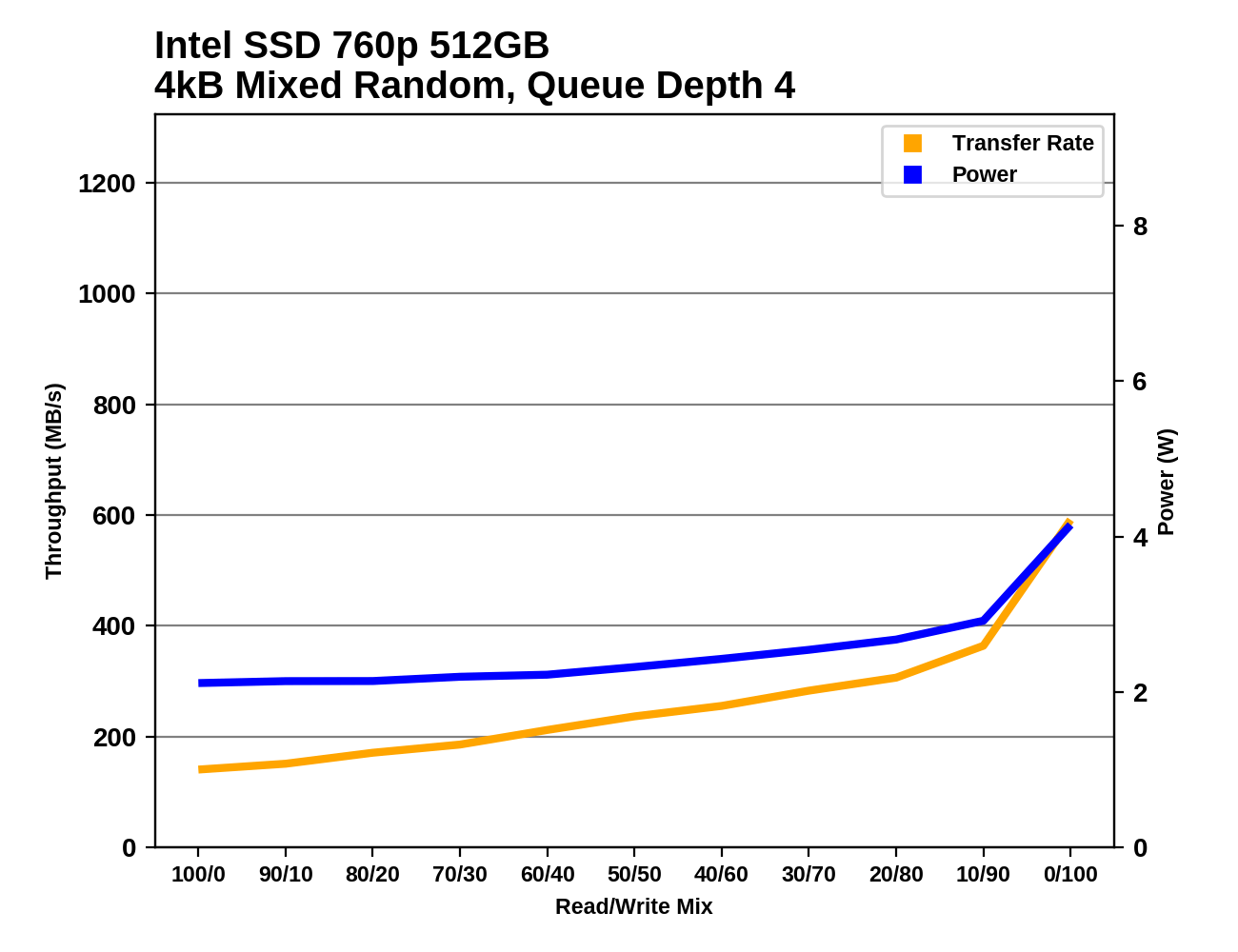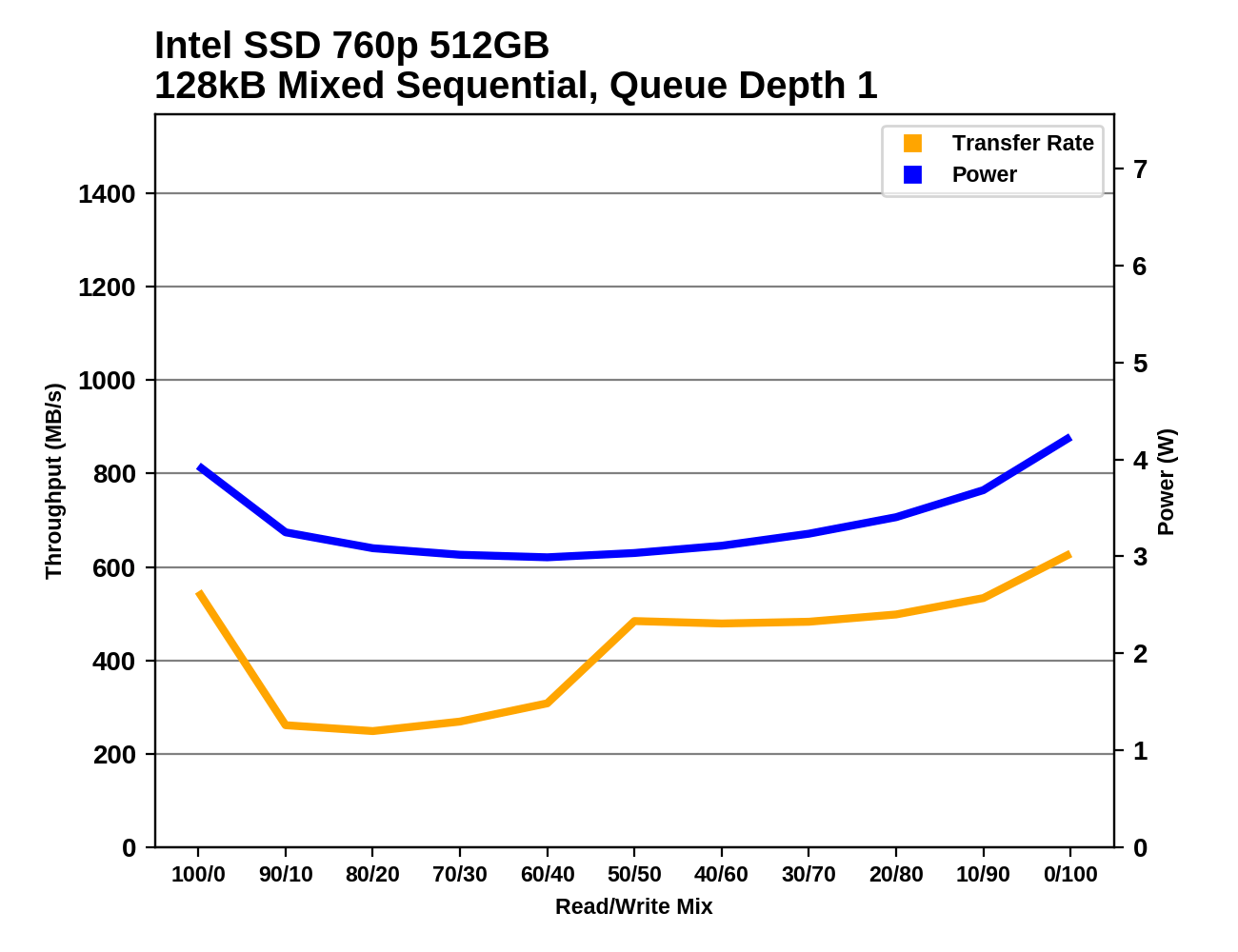The Intel SSD 760p 512GB Review: Mainstream NVMe Done Right
by Billy Tallis on January 23, 2018 11:30 AM ESTMixed Random Performance
Our test of mixed random reads and writes covers mixes varying from pure reads to pure writes at 10% increments. Each mix is tested for up to 1 minute or 32GB of data transferred. The test is conducted with a queue depth of 4, and is limited to a 64GB span of the drive. In between each mix, the drive is given idle time of up to one minute so that the overall duty cycle is 50%.

The overall performance of the Intel SSD 760p on the mixed random I/O performance is quite high for a TLC-based drive. Samsung's PM981 is much better, but the 512GB 760p is almost as fast as the 1TB Samsung 960 EVO. The 760p is clearly a viable competitor to the non-Samsung drives that use MLC NAND flash.

The Intel SSD 760p does not score quite as well for power efficiency as it does for raw performance on the mixed random I/O test, but it is still above average and far better than previous Intel SSDs.
 |
|||||||||
The random I/O performance of the Intel SDD 760p increases gradually but steadily as the proportion of writes increases. It's a good sign that there are no dips in performance along the way, but the performance on the final phase of the test with a pure random write workload is not competitive with the high-end SSDs.
Mixed Sequential Performance
Our test of mixed sequential reads and writes differs from the mixed random I/O test by performing 128kB sequential accesses rather than 4kB accesses at random locations, and the sequential test is conducted at queue depth 1. The range of mixes tested is the same, and the timing and limits on data transfers are also the same as above.

The average performance of the Intel SSD 760p on the mixed sequential workload test does not exceed the limits of a SATA link, but it does clearly beat the best speed achieved by a SATA drive on this test. Previous budget NVMe SSDs have failed to even match the fastest SATA SSDs due to the use of slow TLC NAND.

The power efficiency of the Intel SSD 760p on the mixed sequential I/O test is not great. It only beats drives that were notably slow (600p, WD Black) or unusually power-hungry (Intel 750, Plextor M8PeY). Samsung and Toshiba have set a much higher standard.
 |
|||||||||
The Intel SSD 760p performs much worse during the first half of this test, when the workloads are more read-heavy. By contrast, Samsung's NVMe SSDs tend to be at their worst during the second half of the test. The Samsung drives are much faster at either end of the test when the workload is either pure reads or pure writes, and this helps the Samsung drives secure a clear lead in performance.










51 Comments
View All Comments
Makaveli - Tuesday, January 23, 2018 - link
Its not on the charts because this is a review of budget drives.There would be no point to adding it to this review its in a different performance segment.
emvonline - Tuesday, January 23, 2018 - link
and you cant put it in a notebookiwod - Wednesday, January 24, 2018 - link
I think we have come a long since the first SSD review on Anandtech. And we still have yet to determined the one benchmarks that is representative of real world usage.With these sort of SSD performance I wondered if we are still bottlenecked by IO at all.
The Intel 512GB is now under $200 for MSRP, I bet street price will be even lower, and $100 cheaper then Samsung. While the 128GB and 256GB is much closer, mainly because the cost of controller is fixed, contributing to the bottom line pricing.
Which is why I am sadden, and a little angry, how Apple in 2018, being one of the largest NAND buyer and has an economy of scale, their own SSD Controller, is STILL shipping a HDD on iMac.
xchaotic - Wednesday, January 24, 2018 - link
So why would I want this over the slightly faster and cheaper 960 EVO? (espeically at 256GB it's faster)solar75 - Tuesday, January 30, 2018 - link
Dear BILLY, could you please test several NVME drives in several laptop models to see which ones provide the best speed? I think this will be a very popular review.Shirley Dulcey - Friday, August 31, 2018 - link
Half a year later we can see where the pricing has gone, and it's in a pleasant downward direction.I recently bought a 256GB 760p for a lower-end build (Ryzen 5 2400G, also a bargain at $110) and it's performing very well in that application. It was $60 that day ($65 right now), making it the least expensive option at that capacity other than the store brand drive. The 512GB is $125, but in that capacity class the Crucial MX500 is even more aggressively priced at $100. All in all a great time to be buying an SSD and CPU, but still a lousy one for RAM.
andras1 - Friday, February 8, 2019 - link
So is the 500 GB Intel 760p better in every single aspect (including latency, power, and small random writes/reads) than the 500 GB SATA Samsung 860 EVO?andras1 - Saturday, February 9, 2019 - link
How about full throttle maximum write/read speed power consumption?In which applications is 60ms wake up latency typically a problem? What does this translate to for the average user? Using Visual Studio for programming? Gaming? Internet? Video watching? Handling files?
FastCarsLike - Friday, May 24, 2019 - link
I don't get it, how is it still "TBD", this has been out for almost a year now.ktan112 - Tuesday, July 23, 2019 - link
Is my Intel 760p dying, I'm getting less than half the performance of your results from testing:https://www.userbenchmark.com/UserRun/18676663#DRI...